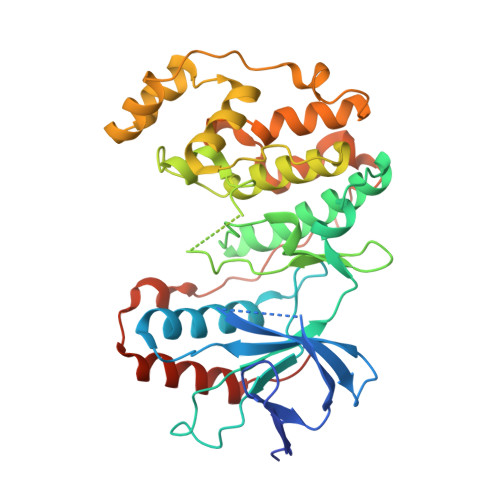Design, Synthesis, and Anti-inflammatory Properties of Orally Active 4-(Phenylamino)-pyrrolo[2,1-f][1,2,4]triazine p38alpha Mitogen-Activated Protein Kinase Inhibitors
Hynes, J., Dyckman, A.J., Lin, S., Wrobleski, S.T., Wu, H., Gillooly, K.M., Kanner, S.B., Lonial, H., Loo, D., McIntyre, K.W., Pitt, S., Shen, D.R., Shuster, D.J., Yang, X., Zhang, R., Behnia, K., Zhang, H., Marathe, P.H., Doweyko, A.M., Tokarski, J.S., Sack, J.S., Pokross, M., Kiefer, S.E., Newitt, J.A., Barrish, J.C., Dodd, J., Schieven, G.L., Leftheris, K.(2008) J Med Chem 51: 4-16
- PubMed: 18072718
- DOI: https://doi.org/10.1021/jm7009414
- Primary Citation of Related Structures:
2RG5, 2RG6 - PubMed Abstract:
A novel structural class of p38 mitogen-activated protein (MAP) kinase inhibitors consisting of substituted 4-(phenylamino)-pyrrolo[2,1- f][1,2,4]triazines has been discovered. An initial subdeck screen revealed that the oxindole-pyrrolo[2,1- f][1,2,4]triazine lead 2a displayed potent enzyme inhibition (IC 50 60 nM) and was active in a cell-based TNFalpha biosynthesis inhibition assay (IC 50 210 nM). Replacement of the C4 oxindole with 2-methyl-5- N-methoxybenzamide aniline 9 gave a compound with superior p38 kinase inhibition (IC 50 10 nM) and moderately improved functional inhibition in THP-1 cells. Further replacement of the C6 ester of the pyrrolo[2,1- f][1,2,4]triazine with amides afforded compounds with increased potency, excellent oral bioavailability, and robust efficacy in a murine model of acute inflammation (murine LPS-TNFalpha). In rodent disease models of chronic inflammation, multiple compounds demonstrated significant inhibition of disease progression leading to the advancement of 2 compounds 11b and 11j into further preclinical and toxicological studies.
- Department of Immunology Chemistry, Bristol-Myers Squibb Pharmaceutical Research Institute, Princeton, New Jersey 08543-4000, USA. john.hynes@bms.com
Organizational Affiliation:

















